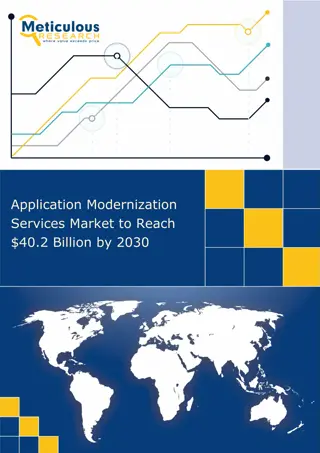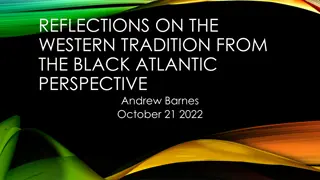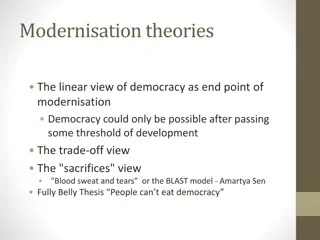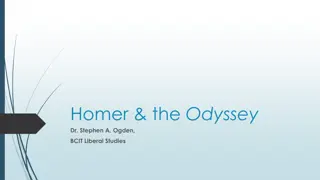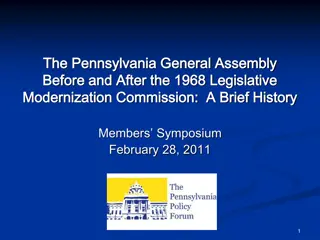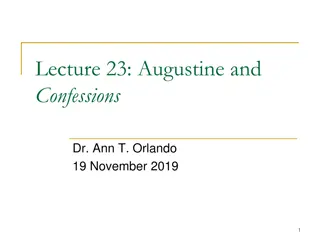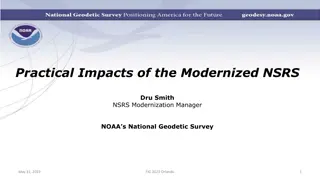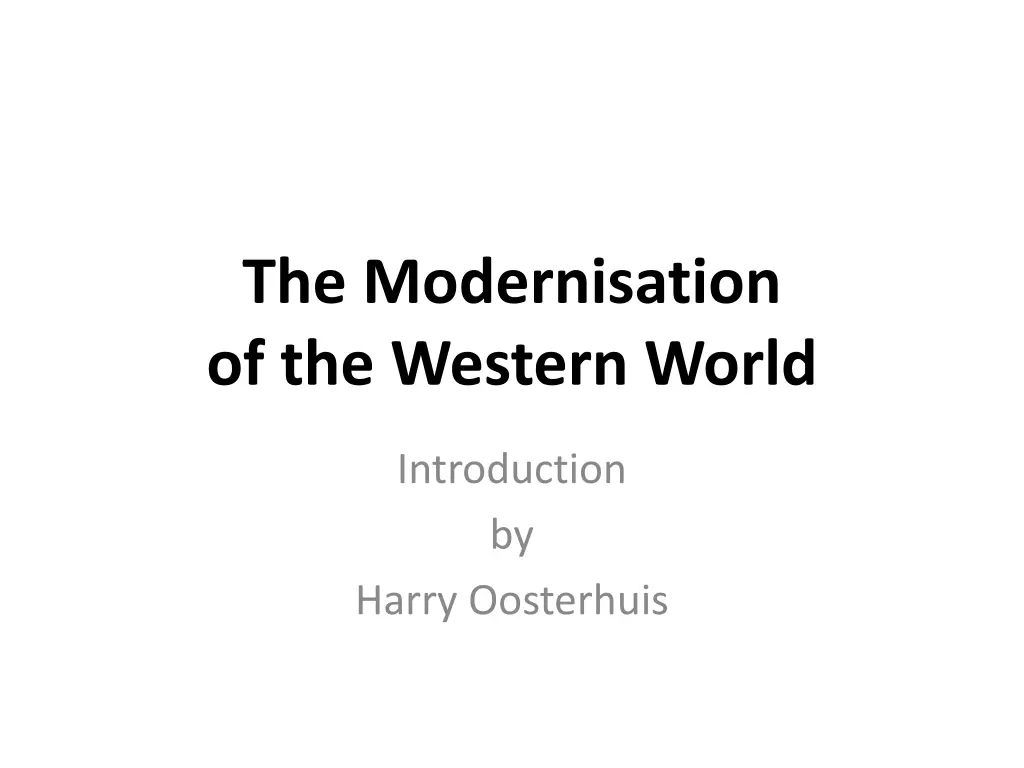
Understanding Modernisation of the Western World Through Key Transformations
Delve into the complexities of modernisation in the Western world through historical processes, associated challenges, and the ambivalence of progress. Explore fundamental transformations in political, socio-economic, cultural, and personal spheres, starting from key events like the American and French Revolutions. Grasp the shift from traditional political orders to modern democratic citizenship, reflecting on gains, losses, and new societal pressures. Witness the evolution towards globalisation, technological advancements, and the impacts on society and the environment.
Download Presentation

Please find below an Image/Link to download the presentation.
The content on the website is provided AS IS for your information and personal use only. It may not be sold, licensed, or shared on other websites without obtaining consent from the author. If you encounter any issues during the download, it is possible that the publisher has removed the file from their server.
You are allowed to download the files provided on this website for personal or commercial use, subject to the condition that they are used lawfully. All files are the property of their respective owners.
The content on the website is provided AS IS for your information and personal use only. It may not be sold, licensed, or shared on other websites without obtaining consent from the author.
E N D
Presentation Transcript
The Modernisation of the Western World Introduction by Harry Oosterhuis
Tradition and culture late 18th early 20th century Modernity: emergence of modern society . Present society outcome of this historical process and it cannot be understood without knowing what this process and the associated problems are about. Nowadays a new phase of modernisation: globalisation, new (information) technologies, supranational capitalism, the crisis of liberal democracy, new social inequalities, new uncertainties and risks (Zygmunt Bauman: liquid modernity ).
The ambivalence of modernisation Improvement? Progress? Gains and losses? Liberation from the shackles of traditional society, from social hierarchies and collective bonds, from authoritarian political regimes, from dogmatic thinking and from a miserable life, full of poverty, hunger, disease, suffering and death. New problems: - social disruption, confusion, uncertainty and disorientation; - the destruction of the natural environment and global warming; - new pressures and constraints: modern society not without new repressive and disciplinary structures.
4 fundamental transformations 1. Political 2. Socio-economic democratisation industrialisation capitalism secularisation, the impact of science/technology individualisation psychologisation 3. Cultural-intellectual 4. Personal/private life
1. Political modernisation: two key events in the age of revolution 1776-1783: the American Revolution against British colonial rule the first modern constitutional and democratic republic, the United States. 1789-1795: the French Revolution, overthrowing the absolutist monarchy and realising the ideal of popular sovereignty.
Traditional modern politics Traditional political order (Ancien R gime): top-down authoritarian government by the privileged few (monarchs, noblemen, patricians, clergy), legitimised by descent, tradition and religion ( Divine Right ). Political modernisation: more and more people involved in politics through the rise of parliamentary government and democratic citizenship, the extension of suffrage, the emergence of political ideologies and parties which organised and politicised the masses. Government justified from below: popular sovereignty.
Political modernisation Traditional Modern authoritarian rule feudalism/absolutism dependent subjects privileges/duties no say in politics personal authority small scale/local democratic politics people s sovereignty free citizens civil rights suffrage/participation political ideologies large scale/national
2. Social-economic modernisation Industrial Revolution starting in late 18th century England, reaching the continent in the early 19thcentury, and expanding to other parts of Europe and America and later also to other parts of the world. Dynamic, large-scale industrial and capitalist society, first on a national and now on a global scale.
Traditional socioeconomic order Static, small-scale, and local social life in village communities, depending on agriculture and handicraft. Scarcity: subsistence economy (struggle for survival). Social positions more or less permanent and determined by collective ties, inherited family- background, fixed hierarchies, rank and status. Division between privileged status groups, such as the nobility and the clergy on the one hand and a rising middle-class and the mass of peasants and workers on the other.
Modern industrial-capitalist order Industrialism: new (material and social) technologies efficient mass-production economic growth. Free-market capitalism: enterprise, economic productivity, and the circulation of capital. Geographic and social mobility: social position and income more and more depending on individual initiative, achievement and merit (meritocracy: use your opportunities, do your best and improve your position). Egalitarianism: equality of opportunity (not necessarily implying equality of outcome). Society dominated by the middle classes versus industrial working class, while decreasing number of people working in agriculture.
Social-economic modernisation Traditional society Modern society agrarian-artisan economic regulation subsistence economy status groups/decent hierarchical static collectivist undifferentiated small-scale industrial free-market capitalism economic growth classes/meritocracy egalitarian social mobility individualistic division of labor large-scale
3. Intellectual-cultural modernisation 17th-century Scientific Revolution 18th-century Enlightenment Paving the way for a secular and rational ( disenchanted ) view of the world and of man. Scientific and technological expertise replacing passed-down knowledge, unquestioned habits and customs, and religious and other magic beliefs as guideline for understanding the world and man.
Changing self-understanding of man Traditional Christian view of man as a special being: the belief that God had endowed human beings with an immortal soul and that their moral destiny lay beyond this world in the hereafter (heaven or hell). Modern secularized image of man: humans are natural, psychological and social beings, who can be studied by science and whose life on earth is a purpose in itself and can be improved.
Intellectual-cultural modernisation Traditional understandings of the world and man Modern religious magical-symbolic passed-down beliefs secular rational scientific/expert knowledge
4. Modernization of personal life Modern (wo)man as an individualized psychological and sexual being. Self-understanding on the basis of an inward turn: growing significance of self-reflection, the intrapsychic dimension and personal identity. Freudian view of man: humans as sexual and largely irrational/emotional beings. Emancipatory and liberating possibilities as well as new strains and anxieties.
Two dimensions of modernisation Historical dimension: political, socio- economic and cultural/intellectual events and developments. Reflective dimension: thinking about the meaning, explanation and evaluation (beneficial or harmful? gains and losses?) of these events and developments.
Where to find these reflections? Intellectual: social theory (sociology) and human sciences (biology, medicine, psychology). Political: ideologies (liberalism, conservatism, socialism, Marxism, nationalism). Artistic: new styles and contents in art. Feedback in process of modernisation: Its historical reality Reflection about its meaning Evaluating response to changing reality, but possibly also influencing the shaping of modern society and man s self-image.
Reflection on modernization: new ways of thinking about man and society: Historical awareness of perpetual change Democratization: egalitarianism and individual and collective/social self-determination Rise of biomedical and human sciences as well as social theory and sociology: rational and secular explanations of man (changing self-image) and modern society Rise of ideologies: political meanings of modern society Social design: man and society shaped and planned
Modernisation as descriptive term and as mobilizing concept Modernity as intended project in order to shape its new social reality: From the Enlightenment onwards the social realities of modernisation were entangled with the intellectual, in particular sociological and political-ideological reflection on and (positive or negative) evaluation as well as the making of modernity. Master narrative since Enlightenment as factor in bringing the reality of modernity about but that reality is less straightforward and more muddled than modernity as ambition and project. Modernity coming in many shapes and sizes. Modernisation should not be understood in a finalist/teleological and presentist way: that history inevitably moves in a linear process towards a pre-ordained goal.
Effect of intellectual, political and artistic reflections on modernity Secularisation and disenchantment : religious, metaphysical and magical interpretations superseded by secular understandings and more rational, practical and down-to-earth attitudes. New ideals and beliefs (modern mind-set): 1. Self-determination 2. Progress 3. Social design
Self-determination Self-determination = autonomy on the basis of independent rational thinking and responsibility. Central in the enlightened project and articulated by Immanuel Kant in An Answer to the Question: What is Enlightenment (1784): Enlightenment is mankind s exit from its self- incurred immaturity. Immaturity is the inability to make use of one s own understanding without the guidance of another. [ ] Have the courage to use your own understanding! [ ] Laziness and cowardice are the reasons why such a great part of mankind [ ] still gladly remain immature for life [ ]. It is so easy to be immature.
Individual and collective self-determination Kant: decide and judge for yourself; take your fate in your hands and liberate yourself from the irrational burden of tradition: from unquestioned beliefs and principles, customary authority, hierarchy and tutelage. Realization of self-determination in the modern world on two levels: Individual personal liberation and emancipation. Collective democratisation of social relations and politics.
Traditional mindset: no progress, fear of change Natural resources are scarce and unpredictable permanent existential insecurity: - Fear of change: leap in the unknown is risky, may undermine existential security and stability. - Orientation towards the past: accumulated customs and the acceptance of inherited values and symbols as the standard. - Continuity as the norm.
Modern belief in progress - Dynamic orientation towards the future in this world: nonstop change and development as the norm (stagnation = decline). - Development = progress, improvement, growth, innovation, overcoming of the past, creative destruction of what is obsolete. - Restlessness of the modern mindset: dissatisfaction with the present situation and the striving for ever more and better.
Modernity: looking and moving forward Past Future Traditional mindset: looking backwards Past Future??? (Death, afterlife)
The optimism of the Enlightenment Confidence in the capacity of the rational mind to advance the economy, technology and culture, and to sweep away everything that was irrational, superstitious and oppressive. Conviction that the course of history now pointed in the direction of continuous improvement and happiness for all.
Nicolas de Condorcet, Tableau historique des progr s de l sprit humain (1795): Reason and the facts of nature do not put any restrictions to the perfectibility of human capacities, [ ] the perfectibility of the human being is open-ended and [ ] progress has no other limit than the life span of the terrestrial globe on which nature situated us.
The irony of Condorcets fate Condorcet finished his book about the progress of the human mind just before dying miserably in a prison cell under the Regime of Terror during the French Revolution, which supposedly had brought the victory of Reason.
Traditional fatalism modern design - Human life is beyond control: lying in the hands of God s will and divine providence and subject to unpredictable and overwhelming natural forces. - Suffering and scarcity are inevitable Christian explanation: since the fall of sinful man from paradise, misery and suffering are inevitable, but there is hope after death (eternal life in heaven).
Modern belief in active intervention and design as the means for realizing a better (perfect?) world: Homo faber: modern man as working, productive and creative being. Political, social, scientific and technological intervention, planning and engineering controlling, (re)making and improving nature, man and society. Man and the social world as object of rational reflection, of efficiency and planning-schemes, bureaucratic administration and management, of blueprints. Utopian thinking: a radical break with the past and making a complete new perfect world.
The ambiguities of modernity Blessings: more comfortable, healthy and longer life; less pain and suffering; material affluence; more security, freedom, human rights, democracy, better education for more people. Drawbacks: (unintended) harmful consequences: - Economic growth depletion of natural resources, pollution and climate-change. - Downsides of technology warfare, surveillance, unemployment, undermining of social bonds, alienation. - Utopian politics totalitarian hells with millions of victims. - Achievement-oriented capitalist meritocracy dictating ever more efficiency, productivity, speed, and profits exploitation, gross inequalities and distress; rat-race with winners and losers. - Psychologisation: inner conflicts, new uncertainties and anxieties about the self.
5 basic questions about modernization 1. What is modernization about? (What is its essence?) 2. How can modernization be explained? (What are its causes?) 3. How should modernization be evaluated? (Optimism versus pessimism) 4. What problems does modernization entail? 5. Can these problems be solved and if so, in what way?
The French revolutionaries 1. Democratization and social design: belief to create a better, rational and just society. Will of rational individuals or the nation to liberate themselves from oppressive, constraining and unjust traditional forces and structures: realization of the ideals of the Enlightenment. Modernization is good and should be advanced: revolution as new beginning, the realization of a new democratic man and the organization of a rational, democratic and just society. Resistance of traditional forces and structures, and all opponents of the revolution ( traitors ) + struggle about the priority of individual versus collective self-determination. (Different views about the extent to which the state should intervene in society and about the realization of liberty, equality and brotherhood .) Empowering central state as rational institution to democratize and equalize society and to unify the nation. 2. 3. 4. 5.
Liberals 1. Liberation of the individual from traditional authoritarian regimes and realization of individual self-determination, and release of market economy from traditional constraints. The natural urge of individuals to be independent and follow their own interests and optimal self-development (natural law - possessive individualism). Positive: opening up of opportunities, free development of the individual and economic growth and prosperity. Increasing power of the state, which hampers or undermines individual self-development and free-market economy. Protecting citizens and free market against the state on the basis of civil rights and rule of law. 2. 3. 4. 5.
Conservatives 1. The disintegration of traditional social bonds, hierarchies, obligations and loyalties as well as religious belief, which guaranteed social stability and cohesion. Abstract rational (= unrealistic) thinking and the (possibly one-sided and fanatic, but hopeless) pursuit of freedom and perfect world (resulting in conflict, violence and terror). Negative: undermining respect for authority, age-old traditions and customs, and bringing disorder, disorientation, instability and dissatisfaction. Unbridled individualism (atomisation/disintegration of communities) and growing power of centralist and rationalized state. Reintroduce intermediate social associations and organisations between state and individual, and foster authority and public morality in order to restore and maintain social cohesion. 2. 3. 4. 5.
Tocqueville 1. Social and political democratization and state-formation: increasing individualization ( equalization of opportunity ) together with political centralization (overlaping liberalism). Enlarging and equalization of economic and educational opportunities, growing geographical and social mobility erosion of traditional collective and hierarchical bonds (overlapping liberalism). Mixed feelings: (social) democratization inevitable and cannot be stopped, but individualization also entails dangers, in particular loss of social cohesion and community-spirit (overlapping conservatism). Individualization may result in atomization and leveling and all-powerful state. Democracy can degenerate in popular despotism, tyranny of majority and rule by populist demagogues. Checks and balances in democracy, in particular a robust civil society and active and responsible citizenship Democratic freedom requires self- control, social cohesion, active attitude and constant vigilance. 2. 3. 4. 5.
Marx and Engels 1. Rise of industrial capitalism: economic interests and relations detached from other social bonds and obligations and dominate social and political life. Development of new technologies, rational organisation and mechanical methods of production: machines and factories. Positive: industrial capitalism brings technological and economic progress and precedes next historical stage: socialism and communism. Private ownership of means of production and free market social- economic inequality and exploitation of labour class by bourgeois- capitalist industrialists. Class-struggle between bourgeois capitalists and the proletarian workers revolution socialisation of the means of production communist society: full equality and self-development for all. 2. 3. 4. 5.
Similarity between Marxist and conservative criticism of capitalism Marx and Engels: All that is solid, melts into air. Capitalism as ruthless a-social and a-moral force that destroys social and moral fabric of society. Different solutions: - Marxism: class-struggle, revolutionary overthrow of liberal-capitalist order new society (utopian). - Conservatism: restoring continuity with tradition (anti-utopian).
Saint-Simon (managerial socialism) Comte (positivism) 1. Functional differentiation: division of labor and specialization, and growing impact of scientific expertise. Emancipation of rational, scientific spirit, replacing religious and metaphysical interpretations of the world (Comte: religious stage metaphysical stage scientific/positivist stage) and realization of efficient economic productivity and meritocracy. (Overlap liberalism) Positive: modernization = progress, increasing scientific knowledge and rational organization, planning and management increasing efficiency and productivity better quality of life. (Overlap liberalism and Marxism) Threat that functional differentiation results in unbridled individualism, social atomization and disintegration. (Overlap conservatism) Individualism should be (1) balanced by organic organization of society enabling functional adaptation and integration of its members and (2) society should be managed by professional experts on basis of scientific and technocratic knowledge. 2. 3. 4. 5.
Tocqueville and Saint-Simon/Comte Similarity - How should modern society be organized after traditional social structures and hierarchies had eroded and lost their function? - How to prevent social atomization and disintegration under new conditions? - How can social order and cohesion be created and maintained in new way? - Contrast different solutions: - Tocqueville s political solution: organization of stable and balanced democracy (democratic institutions and attitudes). - Saint-Simon s and Comte s scientific and technocratic solution: experts and professionals instead of politicians should take a leading role in rational organization and management of industrial society. diagnosis of problem: Today mix of democracy and expertise.
Weber 1. Structural shift from traditional and affective action to goal/value- oriented rational action. Inescapable rationalization: systematic application of instrumental rationality to more and more fields of social life and its institutionalization and internalization. Mixed feelings: rationalization is effective and source of many achievements (control of nature, efficiency, productivity, material progress, high standards of living, well-organized management, justice and democracy) but not without unintended problematical effects. Instrumental rationality becoming end in itself and undermining human freedom: man trapped in web of formal rules, procedures, technical- bureaucratic expertise and routines ( iron cage ) and loss of certainty about purpose and meaning of life (rationality does not provide an answer to the value-oriented question about the good life). No solution : rationalization does not answer the question of which values should direct our lives and does not lead to harmonious society. History dominated by perpetual conflict and power-struggles. 2. 3. 4. 5.
Darwin (not about social modernization, but theory expressing modern mindset and affecting science and social policies) 1. What is evolution about? Emergence and development of life through random variations and changing natural environments. How can evolution be explained? Blind natural forces: life is abundant + natural resources are scarce + random natural variation + different natural environments perpetual struggle for life natural selection survival of the fittest. How does Darwin judge evolution? As neither good nor bad: evolution natural fact and beyond human judgement, beyond good and evil. Disenchanting effect of evolution theory: undermining of self-image of man as a superior being. Should we also consider human society and morality in naturalist/evolutionary terms? Social-Darwinists: yes. Darwin uncertain and ambivalent. Solution? For what? Irrelevant question: evolution has no goal or purpose, no direction, but driven by coincidence, endless struggle and trial and error Nature is unpredictable, does not aim for perfection or harmony. 2. 3. 4. 5.
Social Darwinism (degeneration-theory) 1. Lamarck progressive evolution: natural development, increasing differentiation/division of labor. 2. Free competition/struggle for life the best will survive (nature social and economic life). 3. Mixed feelings: does civilization guarantee or undermine progressive evolutionary development? 4. Survival of inferior regressive evolution: degeneration. 5. Biomedical and social intervention; policies of social/racial hygiene and eugenics (sociobiological design).
Freud about psychological man 1. Increasing demystification/disenchantment of the world and man 2. Emancipation of reason: man and world scientifically explained. 3. Scientific optimism (trust in Enlightenment) and pessimism with regard to man s inner life. 4. Increase of mental and nervous complaints impossibility of harmonious existence and happiness. 5. Therapy? transforming [ ] hysterical misery into common unhappiness.
Different perspectives on modernization historical finalism and teleology modernization is indefinite gains and losses, ambiguities progress and improvement
Ambiguities, contrasts and tensions in modernity constraint, control, discipline Liberation/freedom inequality equality pessimistic realism optimistic meliorism re-enchantment disenchantment Romanticism Enlightenment
Liberation constraint, control, Development of democracy: - individual - liberal democracy French Revolution: - human and civil rights and democracy - ideological fanaticism/intolerance and coercion and terror by the state Tocqueville: - individualization and opening up of opportunities - centralization of political power in the state which may restrict freedom Industrial capitalism: - economic development efficient production and liberation from our dependence of nature, increasing material well-being and prosperity - free market social-economic inequalities; dependence on wage-labor; disciplinary regimen of industrial production; work ethic, new time regimes, alienation, damage to natural environment collective self-determination totalitarian democracy (Talmon)
Democratic liberation versus two constraining social regimes Coercive social and therapeutic interventions and surveillance on the basis of scientific (biomedical, psychiatric, psychological) knowledge about man the disciplinary or more benign regime of surveillance and normalisation. (Foucault) Consequence instrumental rationalisation of social life: systematic administration and management, bureaucracy and governance rigid regime ( iron cage ) of formal rules, standardized procedures, technocratic systems, functionalism and efficiency (Weber).
Equality Inequality Formal political and legal equality in liberal democracy Real social-economic inequalities in industrial capitalism Egalitarian and popular democracy Democracy guided by elites Egalitarian/emancipatory democracy Racism, sexism, classism related to different interpretations of human nature : nurture (meliorism) rationalist universalism inclusion/integration progress/improvement nature as destiny biomedical determinism stigmatization/exclusion regress/degeneration
Optimistic meliorism Pessimistic realism Belief in man s basic rational nature and improvement of man and his condition through social and political intervention, social engineering/design and planning of society. Condition of man as natural and irrational being driven by physical needs, instincts and unconscious urges and who therefore is not master of his own fate.


